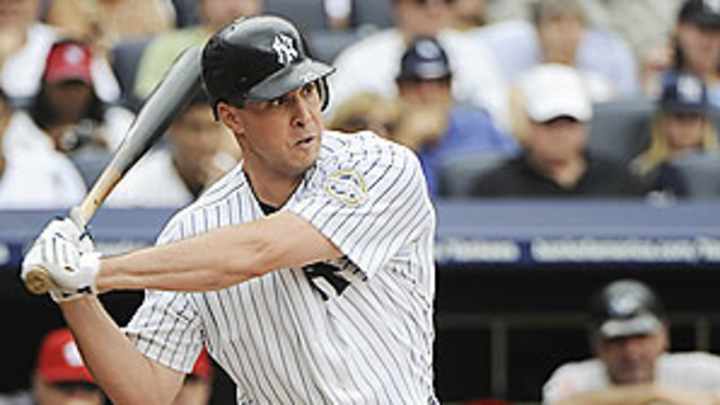Here's why Mark Teixeira could be the next Jason Giambi in pinstripes


Is Mark Teixeira facing a dip in his career? The New York Yankees first baseman turns 31 in April and is coming off a season in which he hit .256 -- 34 points below his lifetime average entering the year (.290). I recently had an interesting discussion with Yankees hitting coach Kevin Long about Teixeira's approach and mechanics and how they are due for adjustments. Three areas stand out for a tuneup:
• Poor starts. Teixeira is a career .235/.342/.411 hitter in April. He basically writes off the first month of his season. To buck this trend, Long is working with Teixeira on taking more swings before spring training begins, as well as making suggestions to tweak the intense pregame workout regimen of Teixeira, a fitness freak.
• Unorthodox mechanics. Teixeira collapses his back side as he hits, rather than driving through the ball with his back side while letting his back foot fully pivot. The style has worked for Teixeira, an accomplished slugger. But the style means that Teixeira must catch the ball out in front and leaves him prone to lifting the ball rather than driving through it. As he ages, Teixeira becomes an even more extreme fly ball and pull hitter, trends that mean he will continue to lose points off his batting average.
• Opposite-field hitting. Teixeira always has been a pull hitter from both sides of the plate, but he virtually gave up hitting the ball the other way last season. From 2003 through '09 Teixeira had between 14 and 22 opposite-field hits each season. Last year he managed only seven.
Long is not about to turn Teixeira into the next Rod Carew, slapping balls the other way. But he believes that if Teixeira makes the adjustment to drive his back side through the ball rather than collapsing it, he will maintain his slugging but also add to his batting average because he will be able to drive the ball to all fields. Long introduced similar adjustments for Nick Swisher last year. What happened? Swisher, a career .245 hitter, batted .288, 43 points above his career average.
Without adjustments, Teixeira is likely to lose more hits into overshifted defenses and lose chunks of points off his batting average as he ages through his 30s and loses the timing and bat speed advantages of youth. If he needs further proof, he can examine the careers of hitters such as Jason Giambi and J.D. Drew. They were versatile, dangerous all-fields hitters through their 20s, but as they aged they worked the ball more and more out in front of them and defenses began overshifting more and more against them to the pull field. Here are the numbers for Giambi and Drew through age 30 -- the stage where Teixeira is now -- and what happened after:
The encore to the Year of the Pitcher has been The Offseason of the Middle Reliever. Consider it an encore that teams will regret.
It has been a great time to be a pitcher that neither starts games nor finishes them. Consider the number of non-closer relief pitchers who signed multi-year contracts in the past five free-agent classes:
2006: 92007: 62008: 72009: 52010: 13
The problem with setup guys is that by the time many of them get to the free-agent market they have been chewed up by the demands of the job, and many of them are older (they often failed as starters first). Setup relievers might be the least predictable performers in baseball, so clubs are spending huge sums of money on guys who historically have a high degree of year-to-year variance.
Let's see what happened the last time clubs spent wildly on setup relievers. After the 2006 season, five setup guys received contracts of three years or more, and all of them were old: Justin Speier, 37, signed for four years with the Angels and Danny Baez, 33 (Orioles), Chad Bradford, 36 (Orioles), Scott Schoenweis, 37 (Mets) and Jamie Walker (Orioles) each signed for three years. Those five relievers were paid an average of $4.4 million per year for 16 combined seasons. How did they work out? None of them made it through their contracts healthy. And here is the average season that those five relievers returned on the investment:
What kind of value did those clubs get? Awful. Consider that Randy Choate posted very nearly that kind of season last year for Tampa Bay: a 4.23 ERA over 44 2/3 innings with no saves. That was worth $1.25 million per year for two years on the free-agent market, courtesy of the Marlins -- just 28 percent of what the five relievers from the Class of '06 were paid for similar work.
Remember all the fuss when Mark McGwire was named hitting coach of the Cardinals a year ago, replacing Hal McRae? What kind of impact did McGwire have? Statistically, almost none.
McGwire generally had the same core group of hitters as McRae. Of the eight players with the most at-bats in each season, six were the same (Albert Pujols, Skip Schumaker, Yadier Molina, Colby Rasmus and Brendan Ryan). The other two spots represented an exchange of Matt Holliday and Felipe Lopez replacing Ryan Ludwick and Rick Ankiel.
The 2010 Cardinals scored precisely six more runs than the 2009 Cardinals and posted the same batting average and on-base percentage. Big Mac's team actually slugged slightly less (.402, down from .415).
The most distinguishable signature was a slight improvement in patience. McGwire's hitters saw more pitches per plate appearance (3.76, 3.66), took more strikes (26 percent of all strikes were looking, up from 24) and swung at a lower percentage of pitches (46, 48), including first pitches of an at-bat (28, 32).
